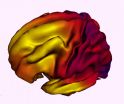Odds of reversing ICU patients' preferences to forgo life-sustaining care vary, Penn study finds
2015-03-30
(Press-News.org) PHILADELPHIA -- Intensive care units across the United States vary widely in how they manage the care of patients who have set preexisting limits on life-sustaining therapies, such as authorizing do-not-resuscitate (DNR) orders and prohibiting interventions such as feeding tubes or dialysis, according to new research from the Perelman School of Medicine at the University of Pennsylvania. Their work is published in the current issue of JAMA Internal Medicine.
"We've long known that end-of-life and critical care varies across nations, regions and centers, whether from changes in local policies, practice culture or resource constraints," said the study's lead author Joanna L. Hart, MD, MSHP, a pulmonary and critical care physician and post-doctoral research fellow at Penn. "But, we hypothesized that by looking at this specific patient population, we could attribute this variability as an appropriate response to patient preferences in care, and undue or unsupported variability. No previous studies we're aware of have analyzed variations in care for patients who, upon admission, have similar care requests."
Hart and colleagues also sought to determine the portion of ICU patients who are admitted with existing treatment limitations - which may have been outlined in advance directives or otherwise ordered by inpatient physician -- and how these patients are managed in the ICU.
The researchers examined a retrospective cohort of patients from 141 intensive care units in 105 hospitals, for a total of 277,693 patients from April 2001 through December 2008 and found that 4.8 percent of ICU admissions were patients with preexisting limits on care. Care limitations for most of these patients included DNR orders, which included preferences prohibiting chest compressions, intubation and use of defibrillation to restart their hearts. Other patients had documented restrictions on acceptable therapies, ranging from dialysis to nutritional support such as feeding tubes (21 percent), and four percent expressed a preference for comfort measures only. Patients admitted with treatment limitations tended to be older than those without such limits (78 years on average) and nearly all had preexisting chronic illnesses conditions, most commonly chronic respiratory disease (14 percent) and chronic kidney disease (13 percent). Most (52 percent) of patients were admitted to the ICU from the emergency department, and 35 percent died during the hospital stay studied.
But the researchers found that these patients' preferences to refrain from use of lifesaving measures were often changed during their stay. Among all patients admitted with treatment limitations, 23 percent of patients nonetheless received CPR in the ICU, with great variability among ICUs: with less than five percent of patients at some ICUs and greater than 90 percent in other ICUs. Overall, 41 percent of patients who entered with treatment limitations received one or more forms of life support, and 18 percent had a reversal of previous treatment limitations during their ICU stay.
The researchers found that when ICU care was managed by a critical care physician, the odds were greater that the preexisting limitations on care would change and their care would be escalated with new forms of life support administered. Suburban hospitals, when compared to urban settings, were found to be associated with greater odds that patients surviving an ICU stay would receive new treatments and have new treatment limitations established during their stay.
"The variability here is astounding and no matter how hard we tried, we could not make it go away by accounting for any differences among the patients admitted to different ICUs," says the study's senior author, Scott Halpern, MD, PhD, MBE, assistant professor of Medicine, Epidemiology, and Medical Ethics and Health Policy. "Surprisingly, for patients who had already outlined 'I don't want this or that procedure or treatment at end of life,' escalations of treatment intensity were nonetheless more common than de-escalations," said Halpern. "This tendency toward aggressiveness varies widely depending only on which ICU a patient happens to be admitted to. There seems to be great potential for better aligning the outcomes of critical care with the outcomes people desire through a better understanding of how treatment decisions are made for patients who can and cannot communicate their preferences. We suggest that having clear, effective advance directives along with accompanying conversations with potential surrogate decision makers (usually family) is the best way to prevent unwanted care during an ICU stay."
INFORMATION:
Penn Medicine is one of the world's leading academic medical centers, dedicated to the related missions of medical education, biomedical research, and excellence in patient care. Penn Medicine consists of the Raymond and Ruth Perelman School of Medicine at the University of Pennsylvania (founded in 1765 as the nation's first medical school) and the University of Pennsylvania Health System, which together form a $4.9 billion enterprise.
The Perelman School of Medicine has been ranked among the top five medical schools in the United States for the past 17 years, according to U.S. News & World Report's survey of research-oriented medical schools. The School is consistently among the nation's top recipients of funding from the National Institutes of Health, with $409 million awarded in the 2014 fiscal year.
The University of Pennsylvania Health System's patient care facilities include: The Hospital of the University of Pennsylvania -- recognized as one of the nation's top "Honor Roll" hospitals by U.S. News & World Report; Penn Presbyterian Medical Center; Chester County Hospital; Penn Wissahickon Hospice; and Pennsylvania Hospital -- the nation's first hospital, founded in 1751. Additional affiliated inpatient care facilities and services throughout the Philadelphia region include Chestnut Hill Hospital and Good Shepherd Penn Partners, a partnership between Good Shepherd Rehabilitation Network and Penn Medicine.
Penn Medicine is committed to improving lives and health through a variety of community-based programs and activities. In fiscal year 2014, Penn Medicine provided $771 million to benefit our community.
ELSE PRESS RELEASES FROM THIS DATE:
2015-03-30
Bacteria have been discovered in the bladders of healthy women, discrediting the common belief that normal urine is sterile. This finding and its implications were addressed in an editorial published by researchers from Loyola University Chicago Stritch School of Medicine (SSOM) in the latest issue of European Urology.
"Clinicians previously equated the presence of bacteria in urine to infections. The discovery of bacteria in the urine of healthy females provides an opportunity to advance our understanding of bladder health and disease," said Alan Wolfe, PhD, lead author ...
2015-03-30
A key protein previously implicated in Lou Gehrig's disease and other neurological diseases plays an important role in the response to viral infection, according to a study led by scientists from the Icahn School of Medicine at Mount Sinai published today in Nature Immunology.
Neurological diseases have long been associated with inflammation, part of the body's response to injury or infection that occurs when immune cells home in to attack invaders like bacteria and viruses, and to drive healing, but the link between them has not been understood.
This new study result ...
2015-03-30
The body's immune system fights disease, infections and even cancer, acting like foot soldiers to protect against invaders and dissenters. But it turns out the immune system has traitors amongst their ranks. Dr. Karin de Visser and her team at the Netherlands Cancer Institute discovered that certain immune cells are persuaded by breast tumors to facilitate the spread of cancer cells. Their findings are published advanced online on March 30 in the journal Nature.
In Western countries about one in eight women will develop breast cancer. Of the women who die of this disease, ...
2015-03-30
Researchers at NYU Langone Medical Center have captured images of the underlying biological activity within brain cells and their tree-like extensions, or dendrites, in mice that show how their brains sort, store and make sense out of information during learning.
In a study to be published in the journal Nature online March 30, the NYU Langone neuroscientists tracked neuronal activity in dendritic nerve branches as the mice learned motor tasks such as how to run forward and backward on a small treadmill. They concluded that the generation of calcium ion spikes -- which ...
2015-03-30
A lower percentage of children are eating fast food on any given day and calories consumed by children from burger, pizza and chicken fast food restaurants also has dropped, according to an article published online by JAMA Pediatrics.
Colin D. Rehm, Ph.D., M.P.H., formerly of the University of Washington, Seattle, now of the Friedman School of Nutrition Science and Policy at Tufts University, Boston, and Adam Drewnowski, Ph.D., of the University of Washington, Seattle, analyzed data from the National Health and Nutrition Examination Survey from 2003 to 2010 to examine ...
2015-03-30
The medication glyburide, which has been increasingly used to treat gestational diabetes in pregnant women, was associated with higher risk for newborns to be admitted to a neonatal intensive care unit, have respiratory distress, hypoglycemia (low blood glucose), birth injury and be large for gestational age compared with infants born to women treated with insulin, according to an article published online by JAMA Pediatrics.
The prevalence of gestational diabetes mellitus (GDM) in the United States has more than doubled during the last 20 years. Given the widespread and ...
2015-03-30
Turns out, an apple a day won't keep the doctor away but it may mean you will use fewer prescription medications, according to an article published online by JAMA Internal Medicine.
The apple has come to symbolize health and healthy habits. But can apple consumption be associated with reduced health care use because patients who eat them might visit doctors less?
Matthew A. Davis, D.C., M.P.H., Ph.D., of the University of Michigan School of Nursing, Ann Arbor, and coauthors analyzed data from the National Health and Nutrition Examination Survey (2007-2008 and 2009-2010) ...
2015-03-30
Scientists have developed tiny 'nanoneedles' that have successfully prompted parts of the body to generate new blood vessels, in a trial in mice.
The researchers, from Imperial College London and Houston Methodist Research Institute in the USA, hope their nanoneedle technique could ultimately help damaged organs and nerves to repair themselves and help transplanted organs to thrive.
The nanoneedles work by delivering nucleic acids to a specific area. Nucleic acids are the building blocks of all living organisms and they encode, transmit and express genetic information. ...
2015-03-30
Characterizing associations between socioeconomic factors and children's brain development, a team including investigators from nine universities across the country reports correlative links between family income and brain structure. Relationships between the brain and family income were strongest in the lowest end of the economic range - suggesting that interventional policies aimed at these children may have the largest societal impact. The study, led by researchers at The Saban Research Institute of Children's Hospital Los Angeles and Columbia University Medical Center, ...
2015-03-30
A new study has confirmed the existence of a positive feedback operating in climate change whereby warming itself may amplify a rise in greenhouse gases resulting in additional warming.
The study, published in the journal Nature Climate Change, shows that in addition to the well understood effect of greenhouse gases on the Earth's temperature, researchers can now confirm directly from ice-core data that the global temperature has a profound effect on atmospheric greenhouse gas concentrations. This means that as the Earth's temperature rises, the positive feedback in the ...
LAST 30 PRESS RELEASES:
[Press-News.org] Odds of reversing ICU patients' preferences to forgo life-sustaining care vary, Penn study finds


